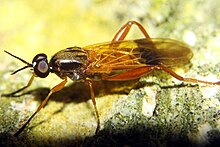This article contains overly lengthy quotations. (May 2024) |
Benhamyia apicalis is a species of soldier fly described by Francis Walker in 1849, who originally called the species Diphysa apicalis.[2][1] It is endemic to New Zealand.
| Benhamyia apicalis | |
|---|---|

| |
| Scientific classification | |
| Domain: | Eukaryota |
| Kingdom: | Animalia |
| Phylum: | Arthropoda |
| Class: | Insecta |
| Order: | Diptera |
| Family: | Stratiomyidae |
| Subfamily: | Beridinae |
| Genus: | Benhamyia |
| Species: | B. apicalis
|
| Binomial name | |
| Benhamyia apicalis | |
| Synonyms | |
| |
Description
editWalker's original 1849 description is as follows:
Head black, hoary in front: eyes pitchy-black; facets of the fore feet rather larger than those elsewhere: palpi and sucker tawny; second joint of the palpi spindle-shaped, not broader than the first: feelers black, filiform, dark red towards the base, nearly as long as the chest: chest and breast dark purple; chest adorned with golden down, which forms three stripes; scutcheon tawny, armed with four teeth: abdomen tawny, a little narrower than the chest and nearly twice its length, slightly decreasing in breadth from the base to the tip, which is purple: legs tawny; hind legs long, their thighs club-shaped ; fore feet pitchy: wings colourless on the disk, tawny along the fore border, gray along the hind border and at the tip, adorned with a blackish band which does not reach the hind border; wing-ribs and veins tawny; veins pitchy on the blackish band; poisers pale yellow. Length of the body 31⁄2 lines; of the wings 7 lines.[1]
Distribution
editThe species is endemic to New Zealand, found on both the North Island and South Island.[3]
Gallery
edit-
Benhamyia apicalis on a tree in Christchurch
-
Two Benhamyia apicalis mating in Dunedin
-
Specimen from Lincoln
-
Specimen from Dunedin
-
Close-up of the wings of Benhamyia apicalis
References
edit- ^ a b c Walker, Francis (1849). List of the specimens of dipterous insects in the collection of the British Museum. Part IV. Vol. 4. London: British Museum. pp. 1151–1152.
- ^ Gordon, Dennis P., ed. (2010). New Zealand inventory of biodiversity: Kingdom animalia: chaetognatha, ecdysozoa, ichnofossils. Vol. 2. ISBN 978-1-877257-93-3. OCLC 973607714. OL 25288394M. Wikidata Q45922947.
- ^ "Benhamyia apicalis". Global Biodiversity Information Facility. Retrieved 20 April 2024.